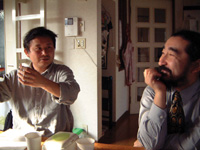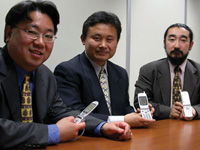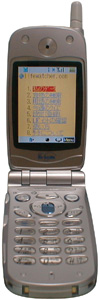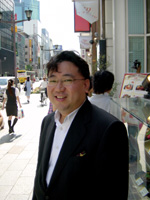Keitai Care: James Nakagawa's Mobile Marvel
Back to Contents of Issue: December 2003
|
|
|
|
by John Alderman |
|
|
With assessments ranging from 6 million to 16.2 million diabetics in Japan -- and over 70 million mobile phone users -- a large niche is clearly waiting to be filled. While the marketing departments of major mobile manufacturers are obsessed with the frivolous end of personalization (such as cutesy screen animations and fleetingly amusing ringtones), Lifewatcher is a reminder that much more useful services are both possible and profitable.
James H. Nakagawa, the Japanese-Canadian chairman and CEO of Mobile Healthcare KK, the Tokyo firm that created Lifewatcher, says that a talk with a friend who had been recently diagnosed as diabetic changed his perspective on self-care. The friend described his situation in bleak terms and said that there was nothing he could do to help himself. He was given no options by his doctor other than drugs and a list of severe restrictions.
Calls by Nakagawa to specialists and acquaintances confirmed both the incredible rise of the disease in Japan and the difficulties in managing it. Constantly monitoring food intake is hard, and it is often impossible for most patients to find out the nutritional information at restaurants, effectively barring them from eating out with friends. Depression often accompanies the diagnoses of patients new and old. From a doctor's perspective, patients are often lethargic and forgetful, prone to slipping off their regimes of diet and exercise. Even when patients are cooperative, a busy schedule often prevents doctors from effectively communicating with them between visits.
Looking at other systems, Nakagawa was shocked not only that no one offered a service for mobile phones, but also that the user interfaces were so poor. "My god," he says, "it took you 20 minutes to find the calories of a McDonald's or Mos Burger sandwich." That is unacceptable in any medical regime, where "the main challenge is making it a habit."
By using a mobile phone rather than a palm top computer, Lifewatcher is part of the most popular platform in Japan. And with the addition of networked functions like the restaurant search, it takes the service from a nice idea to a very handy tool.
When dealing with children as well as impatient adults, ease of use is a must. Developed with advice from Japanese doctors and the Japan Red Cross, the system lets registered health care providers (and children's parents) monitor use and results so that they can confirm medicine intake and exercise and be aware of any abnormalities. But no matter who is tracking their stats, Nakagawa believes Lifewatcher's convenience and comprehensiveness increases patients' self-reliance, which in turn lowers depression.
Company materials boldly declare that "users will see an immediate improvement in quality of life." Nakagawa's background as a successful high-tech financial service consultant without notable credentials gave him the notion that insight, hard work and networking are much more important than certificates.
Others around the world share the enthusiasm. Hospitals like Moses Cone in Greensboro, North Carolina, and universities such as the Euromed project in Athens, Greece, are hatching plans to make use of handheld wireless tools for patients and doctors. Mobile Tree in Bellevue, Washington, specializes in letting doctors write prescriptions and access patient history from PDAs.
While researchers articulate ambitious schemes for tele-medicine that look forward to doctors and hospitals linking data for MRI and X-Ray images and other patient medical history, the advantage of Lifewatcher is that it focuses on a particular need and does it well. Nakagawa emphasizes that the system is being constantly analyzed and updated, while the database of foods, stores and restaurants is also growing. Also, since Lifewatcher is not medical advice but rather a tool for self-help and activity tracking, it has room to maneuver without running into too many legal traps or liabilities.
One of the hardest parts of Nakagawa's job has been convincing Japanese restaurants and food stores to provide information. Nakagawa is persistent in the face of uncooperative food sellers, explaining the numerous benefits to contributing information. Many others have signed on, particularly the more American or American-style chains that hope to make their image healthier, like McDonald's, Mos Burger and Denny's. Evidently, it's much easier for major chains to offer the nutritional value of foods whipped out on the company assembly line than it is for Tokyo's legion of mom and pop eateries to assess the number of calories in their daily specials.
The company is able to access and use databases of nutritional content generated by the Japanese and American governments. But sometimes it isn't even the nutritional information that is the sticking point. One major convenience store chain refused to disclose the locations of its stores, which suggested a fear of networked information and databases more than anything else.
Money may speak loudly to other segments of society, too; the government and health insurance companies might recognize that spending on prevention of diabetes and cardiovascular disease will be recouped by having healthier citizens and customers.
"I blame the [phone] carriers for promoting light strategies," Nakagawa says. What good is an increasing level of mobile power, he wondered, if it's only used for increasingly grating song jingles? The carriers may not be villains, but they are a little misdirected.
Nakagawa believes that the benefits of a well-designed, useful system give it a selling point that doesn't need embellishment and will last much longer than the life cycle of faddish consumer trends. "Healthcare doesn't need hype."
It sounds convincing, and the Japanese Ministry of Health's National Health Service actually covers up to 70 percent of Lifewatcher's costs if it is prescribed. One of the Mobile Healthcare's market strategies is to sell Lifewatcher as a prescription-based delivery and employee benefit of national health insurance.
Looking beyond Japan, Nakagawa makes a strong case for tools such as his being supported by insurance companies and hospitals around the world, particularly in areas with high rates of mobile penetration and lifestyle diseases crying out for convenient tools. Not only would costs be kept down, but Lifewatcher-type services would help providers and insurance companies differentiate themselves. A McKinsey report in 2001 noted that "disease-management programs could help insurers reap net savings of 10 to 30 percent from specific groups of patients."
If the carriers haven't been particularly helpful, other major players have. Nakagawa got very early support from Apple Computer Japan, and the global giant is now giving Mobile Healthcare full partner software status and technical support. The Japan Red Cross also supports the project, having contributed several technical studies.
Others might worry that doing all the legwork to craft a market from scratch could be risky, especially if the idea is stolen by a well-funded aggressor. But Nakagawa says he "welcomes more entrants into the market," partly because he would appreciate other efforts to raise awareness about mobile healthcare -- but also because he knows his niche. @ |
|
Note: The function "email this page" is currently not supported for this page.


 LIFEWATCHER IS A MOBILE "Disease Management Solution for Diabetes and Obesity" at the intersection of two important trends: software tools that empower individual lifestyles and a rise in "lifestyle diseases," whose treatment requires long-term management rather than an instant cure. Both of these trends have surged in Japan.
LIFEWATCHER IS A MOBILE "Disease Management Solution for Diabetes and Obesity" at the intersection of two important trends: software tools that empower individual lifestyles and a rise in "lifestyle diseases," whose treatment requires long-term management rather than an instant cure. Both of these trends have surged in Japan.
 "What if we could create a Disease Management Solution that was not light but could be carried by anyone with a mobile phone?" Nakagawa wondered. As opposed to what he terms "light" services -- simple calorie-counting tools -- Lifewatcher not only provides loads of tools that let users input, track and graph their nutritional intake and exercise, it also offers convenient add-ons like meal suggestions based on user needs and desires, along with addresses and other details of local stores or restaurants serving the suggested healthy picks. Lights flash or messages are sent as reminders if users don't report having taken their medicine.
"What if we could create a Disease Management Solution that was not light but could be carried by anyone with a mobile phone?" Nakagawa wondered. As opposed to what he terms "light" services -- simple calorie-counting tools -- Lifewatcher not only provides loads of tools that let users input, track and graph their nutritional intake and exercise, it also offers convenient add-ons like meal suggestions based on user needs and desires, along with addresses and other details of local stores or restaurants serving the suggested healthy picks. Lights flash or messages are sent as reminders if users don't report having taken their medicine.
 While nothing stops patients from being lazy or doctors from being too busy to monitor them, Nakagawa says all of the doctors he spoke with were enthusiastic about the system.
While nothing stops patients from being lazy or doctors from being too busy to monitor them, Nakagawa says all of the doctors he spoke with were enthusiastic about the system.
 "I stopped trying to reason why and started going around [to the stores]," Nakagawa says. After all, he feels that the legions of diabetics represent a "captured demographic" -- an easily targeted market segment -- and the currently unconvinced are likely to change their minds as the lucrative market proves itself.
"I stopped trying to reason why and started going around [to the stores]," Nakagawa says. After all, he feels that the legions of diabetics represent a "captured demographic" -- an easily targeted market segment -- and the currently unconvinced are likely to change their minds as the lucrative market proves itself.



